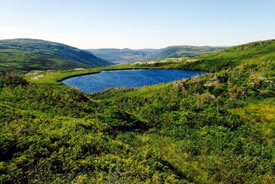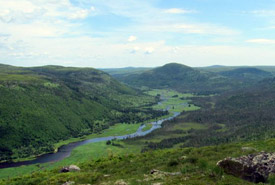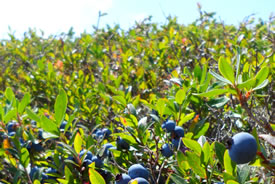Yes, B’y! Adventures in the Grassy Place.

Mountaintop lake, Grassy Place, NL (Photo by NCC)
As conservation planner for the Nature Conservancy of Canada’s (NCC's) Nova Scotia and Newfoundland programs, I am fortunate to have visited some truly astonishing places in the Atlantic Region. The latest mission was to reach a 3,880-acre (1,570-hectare) parcel of land aptly named The Grassy Place.
The Grassy Place is nestled in Western Newfoundland’s Long Range Mountains, the most northerly extension of the Appalachians Mountain Chain. Though they are still quite humbling, it is hard to imagine that these smooth rolling barren tops once towered as high as the Rocky Mountains of the west do today.
The adventure begins
We arrived in Newfoundland and quickly readied our supplies and food for our six days in the bush. We set off from our last refuge of civilization and comfort and began the full day’s journey into the Newfoundland wilderness.
We went as far up a logging road that we could manage before it quickly disintegrated into a twisting, undulating, washed out mess. It was there that we met the Grassy Place steward, Mike, to take us the final 12 kilometres to the entrance point. On more than one occasion, I was certain that we had reached the end of the line and the rest of the journey would be completed on foot. To my surprise and relief, the truck just kept on truckin.’
Mike was the master of his domain and he would not be held up by a measly three-foot deep washout, let alone a dozen of them. He was a man on a mission, and despite a punctured power steering line, we would reach the launching point for the final leg of the journey.
From here we would have to hike the final six kilometres into the valley. After trekking up and over the hills that divided us from our destination, we would have, what would be for most of us our first view of The Grassy Place.

Grassy Place, Newfoundland and Labrador (Photo by NCC)
A world champion of natural beauty
I consider myself a fairly well-traveled individual. Having spent the lion’s share of my twenties travelling to nearly 35 countries, I am lucky enough to have seen some the planet’s most pristine and awe-inspiring landscapes.
The view down over the valley from the spanning barrens high above the Grassy Place, while in tough company, can easily hold its own against the world champions of natural beauty. The mountains aren’t towering and the hillsides are not fortified with 1,000-year-old trees, but it is the complete entanglement of individual natural splendours stitched up into a unique and exceptional landscape that gives the Grassy Place a rarely rivaled splendour.
Our office with a view
This, to my core’s content, is where we would spend the next six days working: exploring the land and classifying its life-sustaining ecosystems.
The Nature Conservancy of Canada's Atlantic Region has recently begun to quantify the various ecosystem types that occur on NCC properties within the four Atlantic Provinces. Adapted from the Nova Scotia Department of Natural Resources Forest Ecosystem Classification Key, the plan is to roll up an inventory of ecosystem types to help inform what types are not well represented within our property ownership. This multi-year project involves visiting each property and completing an ecosystem classification database that will, in the end, allow our property prioritization and acquisition to be more efficient and lead to the increased protection of the most under-represented habitat types.
Our time in the Grassy Place was spent trying to access as much as the property as possible to take down in the detail the various ecosystems that blanketed the landscape. This included criss-crossing the valley slopes, clambering over deadfall and avoiding leg-snapping sinkholes to determine the forest types; trudging through wetlands looking for rare or unique plant species; scaling waterfalls to reach the valley peaks; and canoeing the river valley to reach the far corners of the property boundary.
Each day was a gruelling physical challenge and we returned to camp each evening dripping with the sweat of a hard day’s work. The evenings were occupied with Megan’s incredible re-hydrated delicatessens, rousing games of Hearts and the stories and conversations that only darkness and distance can stimulate.

Blueberries at the Grassy Place, NL (Photo by NCC)
Back to reality
On the morning of day six, we had come to the end of our time in the Grassy Place. We were leaving with recollections of moose and bird sightings, countless black bear and caribou tracks, bioluminescent fungi, mountain top lake swims, grape sized blueberries, and most importantly 3,880 acres of classified ecosystems. We were now due to return to where the excursion began five nights prior.
We left on foot, gear in tow, to meet another local Nature Conservancy of Canada supporter and his awaiting transportation. After a six- or seven-kilometre hike, most of it waist deep along a lake’s edge, we rendezvoused with our help. He carried the bulk of our gear while the rest of us hiked the final 12 kilometres back to where we had left our truck on the first day.
With the Grassy Place well in distance, we made our way back toward the Deer Lake airport, where we would go our respective ways, knowing that we had all shared in a remarkable experience.
The Grassy Place is an enchanting oasis that NCC should be proud to hold in its vast network of conservation lands across Canada. It is a topographic and ecological treasure that should be high on anyone’s list making the trip over to the “Rock.” I may not see it again for some time, but I feel that having been there and walked among the tall grasses of the valley floor, ascended the valley slopes and traversed the seemingly never-ending barrens beyond the ridgeline, I am a part of a relatively small and privileged group of human beings to truly know this majestic place.

